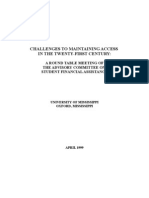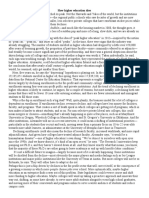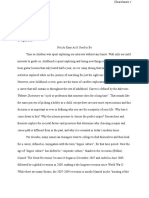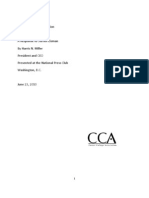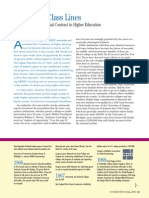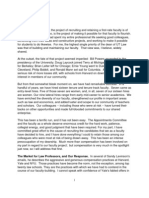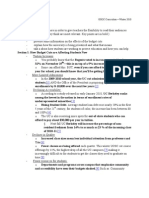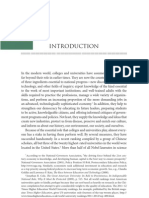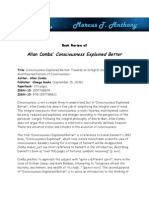Jeffrey Williams Debt and Indenture
Jeffrey Williams Debt and Indenture
Uploaded by
Annie McClanahanCopyright:
Available Formats
Jeffrey Williams Debt and Indenture
Jeffrey Williams Debt and Indenture
Uploaded by
Annie McClanahanOriginal Description:
Copyright
Available Formats
Share this document
Did you find this document useful?
Is this content inappropriate?
Copyright:
Available Formats
Jeffrey Williams Debt and Indenture
Jeffrey Williams Debt and Indenture
Uploaded by
Annie McClanahanCopyright:
Available Formats
Student Debt and The Spirit of Indenture
Jeffrey J. Williams
Dissent, Volume 55, Number 4, Fall 2008 (whole No. 233), pp. 73-78 (Article) Published by University of Pennsylvania Press DOI: 10.1353/dss.2008.0076
For additional information about this article
http://muse.jhu.edu/journals/dss/summary/v055/55.4.williams.html
Access provided by Cornell University (27 Mar 2013 19:54 GMT)
Student Debt and The Spirit of Indenture
Jeffrey J. Williams
HEN WE think of the founding of the early colonies, we usually think of the journey to freedom, in particular of the Puritans fleeing religious persecution to settle the Massachusetts Bay Colony. But it was not so for a majority of the first Europeans who emigrated to these shores. "Between one-half and two-thirds of all white immigrants to the British colonies arrived under indenture," according to the economic historian David W. Galenson, a total of three hundred thousand to four hundred thousand people. Indenture was not an isolated practice but a dominant aspect of labor and life in early America. Rather than Plymouth, Jamestown was a more typical example of colonial settlement, founded in 1607 as a mercantile venture under the auspices of the Virginia Company, a prototype of "joint-stock" corporations and venture capitalism. The first colonists fared badly because, coming primarily from gentry, they had little practical skill at farming and were ravaged by starvation and disease. In 1620, the Virginia Company shifted to a policy of indentured servitude to draw labor fit to work the tobacco colonies. Indenture had been a common practice in England, but its terms were relatively short, typically a year, and closely regulated by law. The innovation of the Virginia Company was to extend the practice of indenture to America, but at a much higher obligation, of four to seven years, because of the added cost of transit, and also because of the added cost of the brokerage system that arose around it. In England, contracts of indenture were directly between the landowner and servant, whereas now merchants or brokers in England's ports signed prospective workers, then sold the contracts to
shippers or to colonial landowners upon the servants' arrival in America, who in turn could re-sell the contracts. By about 1660, planters "increasingly found African slaves a less expensive source of labor," as Galenson puts it. An economically minded historian like Galenson argues that the system of indenture was rational, free, and fairone had a free choice to enter into the arrangement, some of those indentured eventually prospered, and it was only rational that the terms be high because of the cost of transitbut most other historians, from Edmund S. Morgan to Marcus Rediker, agree that indentured servitude was an exploitive system of labor, in many instances a form of bondage akin to slavery. For the bound, it meant long hours of hard work, oftentimes abuse, terms sometimes extended by fiat of the landowner, little regulation or legal recourse for laborers, and the onerous physical circumstances of the new world, in which two-thirds died before fulfilling their terms. College student-loan debt has revived the spirit of indenture for a sizable proportion of contemporary Americans. It is not a minor threshold that young people entering adult society and work, or those returning to college seeking enhanced credentials, might pass through easily. Because of its unprecedented and escalating amounts, it is a major constraint that looms over the lives of those so contracted, binding individuals for a significant part of their future work lives. Although it has more varied application, less direct effects, and less severe conditions than colonial indenture did (some have less and some greater debt, some attain better incomes) and it does not bind one to a particular job, student debt permeates everyday experience with concern over the monthly chit and encumbers job and life choices. It also takes a page from indenture in the extensive brokerage system it has bred, from which more
DISSENT / Fall 2008 n 73
STUDENT DEBT
than four thousand banks take profit. At core, student debt is a labor issue, as colonial indenture was, subsisting off the desire of those less privileged to gain better opportunities and enforcing a control on their future labor. One of the goals of the planners of the modern U.S. university system after the Second World War was to displace what they saw as an aristocracy that had become entrenched at elite schools; instead they promoted equal opportunity in order to build America through its best talent. The rising tide of student debt reinforces rather than dissolves the discriminations of class, counteracting the meritocracy. Finally, I believe that the current system of college debt violates the spirit of American freedom in leading those less privileged to bind their futures. In a previous essay, "Debt Education," in the summer 2006 issue of Dissent, I detailed the basic facts and figures of student-loan debt, pointed out how it rewrites the social contract from a public entitlement to education to a privatized service, and teased out how it teaches less than humanistic lessons, about education as a consumer good, about higher education as job training rather than intellectual exploration, and about civil society as a commercial market rather than a polis. I also promoted some solutions, notably the U.S. Labor Party's proposal for FreeHigherEd and fortified forms of public service linked with college. Here, I look more seriously at the analogy to indenture. While it might not be as direct or extreme a constraint as indentured servitude, student debt constrains a great many of Americans. It represents a turn in American thought and hope to permit such a constraint on those attempting to gain a franchise in the adult or work world. I also want to promote a relatively little known proposal for relieving some of the most inequitable terms of student debt, "Income Contingent Loans."
NDENTURED SERVITUDE seems a strange and distant historical practice, like debtors' prison. But there are many ways that college student-loan debt revises for the twentyfirst century some of its ethos and features:
Prevalence Student-loan debt is now a prevalent mode of financing higher educa-
tion, applying to two-thirds of those who attend. If upward of 70 percent of Americans attend college at some point, it applies to half the rising population. Like indenture through the seventeenth century, it has become a common experience of those settling the new technological world of twenty-firstcentury America, in which we are continually told that we need college degrees to compete globally. Amounts Student debt has morphed from relatively small amounts to substantial ones, loosely paralleling the large debt entailed by colonial transport. The average federal loan debt of a graduating senior in 2004 (the most recent year for which statistics are available) was $19,200. Given that tuitions have nearly doubled in the last decade and grants have barely risen, and that debt more than doubled from 1994, when it was $9,000, not to mention from 1984, when it was $2,000, one can assume that the totals will continue to climb. Also consider that, as happens with averages, many people have significantly more than the median23 percent of borrowers attending private and 14 percent attending public universities have over $30,000 in undergraduate loans. Added to federal loans are charge cards, estimated at $2,169 per student in 2004, quite often used for necessities; private loans, which have quintupled in number since 1996, when 1 percent of students took them, to 5 percent in 2004, and which have risen in total to $17.3 billion in 2005, a disturbingly large portion in addition to the $68.6 billion for federal loans; and, for over 60 percent of those continuing their educations, graduate-student debt, which more than doubled in the past decade, to a 2004 median of about $28,000 for those with master's degrees, $45,000 for doctorates, and $68,000 for professional degrees. Length of term Student debt is a longterm commitmentfifteen years for standard Stafford guaranteed federal loans. With consolidation or refinancing, the length of term frequently extends to thirty yearsin other words, for many returning students or graduate students, until retirement age. It is not a transitory bond, say, of a year for
7 4 n DISSENT / Fall 2008
STUDENT DEBT
those indentured in England or of early student debtors who might have owed $2,000. To be sure, it is not as concentrated as colonial indenture, but it is lengthier and weighs down a student debtor's future. Transport to work Student indebtedness is premised on the idea of transport to a jobthe figurative transport over the higher seas of education to attain the shores of credentials deemed necessary for a middle class job. The cost of transport is borne by the laborer, so an individual has to pay for the opportunity to work. Some businesses alleviate debt as a recruiting benefit, but unfortunately they are still relatively few. (Another factor is the precipitous rise in student work hours, as Marc Bousquet's stunning indictment, How the University Works, recounts. According to recent statistics, students at public universities work an average of twenty-five hours a week, which tends to lower grades and impede graduation rates. Servitude, for many current students, begins on ship.) Personal contracts "Indenture" designates a practice of making contracts before signatures were common (they were torn, the tear analogous to the unique shape of a person's bite, and each party held half, so they could be verified by their match); student debt reinstitutes a system of contracts that bind a rising majority of Americans. Like indenture, the debt is secured not by property, as most loans such as those for cars or houses are, but by the person, obligating his or her future labor. Student-loan debt "financializes" the person, in the phrase of Randy Martin, who diagnoses this strategy as a central one of contemporary venture capital, displacing risk to individuals rather than employers or society. It was also a strategy of colonial indenture. Limited recourse Contracts for federal student loans stipulate severe penalties and are virtually unbreakable, forgiven only in death, not bankruptcy, and enforced by severe measures, such as garnishee and other legal sanctions, with little recourse. (In one recent case, the Social Security payment to a person on disability was garnisheed.) In England, indenture was regulated by law,
and servants had recourse in court; one of the pernicious aspects of colonial indenture was that there was little recourse in the new colonies. Class Student debt applies to those with less family wealth, like indenture reinforcing class differences. That this would be a practice in imperial Britain, before modern democracy and where classes were rigidly set, is not entirely surprising; it is more disturbing in the United States, where we ostensibly eschew the determining force of class. The one-third without student debt face much different futures, and are more likely to pursue graduate and professional degrees (three-quarters of those receiving doctorates in 2004 had no undergraduate debt, and, according to a 2002 Nellie Mae survey, 40 percent of those not pursuing graduate school attributed their choice to debt). Student debt is digging a class moat in present-day America. Youth Student debt incorporates primarily younger people, as indenture did. One of the more troubling aspects of student debt is that often it is the first step down a slope of debt and difficulties. Tamara Draut, in her expos Strapped: Why America's 20and 30-Somethings Can't Get Ahead, shows how it inaugurates a series of strained conditions, compounded by shrinking job prospects, escalating charge card debt, and historically higher housing payments, whether rent or mortgage, resulting in lessened chances for having a family and establishing a secure and comfortable life. The American Dream, and specifically the postSecond World War dream of equal opportunity opened by higher education, has been curtailed for many of the rising generation. Brokers Student debt fuels a financial services system that trades in and profits from contracts of indebted individuals, like the Liverpool merchants, sea captains, and planters trading in contracts of indenture. The lender pays the fare to the college, and thereafter the contracts are circulated among Sallie Mae, Nellie Mae, Citigroup, and four thousand other banks. This system makes a futures market of people and garners immense profit from them. The federDISSENT / Fall 2008 n 7
STUDENT DEBT
ally guaranteed student loan program was originally a nonprofit corporation, Sallie Mae, but in 2004 Sallie Mae became a private, for-profit corporation, reporting record profits in its first three years. State policy The British crown gave authority to the Virginia Company; the U.S. government authorizes current lending enterprises and, even more lucratively for banks, underwrites their risk in guaranteeing the loans (the Virginia Company received no such largesse and went bankrupt). In the past few years, federal aid has funneled more to loans rather than any other form of aid (52 percent of all federal aid, whereas grants account for 42 percent). My point in adducing this bill of particulars is not to claim an exact historical correspondence between indentured servitude and student indebtedness. But, as I think these particulars show, it is not just a fanciful analogy either. The shock of the comparison is that it has any resonance at all, and that we permit, through policy and practice, the conscription of those seeking the opportunity of education, especially the young, into a significant bond on their future labor and life. While indenture was more direct and severe, it was the product of a rigidly classed, semi-feudal world; student debt is more flexible, varied in application, and amorphous in effects, a product of the postmodern world, but it revives the spirit of indenture in promulgating class privilege and class subservience. What is most troubling is that it represents a shift in basic political principle. It turns away from the democratic impetus of modern American society. The 1947 Report of the President's Commission on Education, which ushered in the vast expansion of our colleges and universities, emphasized (in bold italics) that "free and universal access to education must be a major goal in American education." Otherwise, the commission warned, "If the ladder of educational opportunity rises high at the doors of some youth and scarcely rises at the doors of others, while at the same time formal education is made a prerequisite to occupational and social advance, then education may become the means, not of eliminating race and class dis-
tinctions, but of deepening them." Their goal was not only an abstract one of equality, but also to strengthen the United States, and, by all accounts, American society prospered. Current student debt weakens America, wasting the resource of those impeded from pursuing degrees who otherwise would make excellent doctors or professors or engineers, as well as creating a culture of debt and constraint.
HE COUNTERARGUMENTS for the rightness of student-loan debt are similar to the counterarguments for the benefits of indenture. One holds that it is a question of supply and demanda lot of people want higher education, thus driving up the price. This doesn't hold water, because the demand for higher education in the years following the Second World War through 1970 was proportionately the highest of any time, as student enrollments doubled and tripled, but the supply was cheap and largely state funded. The difference between then and now is that higher education was much more substantially funded through public sources, both state and federal; now the expense has been privatized, transferred to students and their families. Galenson argues that with indenture, "long terms did not imply exploitation" because they were only fitting for the high cost of transport; that more productive servants, or those placed in undesirable areas, could lessen their terms; and that some servants went on to prosper. He does not mention the rate of death, the many cases of abuse, the draconian extension of contracts by unethical planters, nor simply what term would be an appropriate maximum for any person in a free society to be bound, even if they agreed to the bondage. Galenson also ignores the underlying political question: Is it appropriate that people, especially those entering the adult world, might take on such a longterm commitment of constraint? Can people make a rational choice for a term they might not realistically imagine? Even if one doesn't question the principle of indenture, what is an appropriate cap for its amounts and term? In the case of student debt, although it might be a legal choice, it is doubtful whether it is always a rational choice for those who have no knowledge of adult life. One of the more haunt-
7 6 n DISSENT / Fall 2008
STUDENT DEBT
ing responses to the 2002 Nellie Mae survey was that 54 percent said that they would have borrowed less if they had to do it again, up from 31 percent ten years before. One can only imagine that this informed judgment will climb as debt continues to rise. Student-loan debt is justified in terms similar to Galenson's by some current economists. Because college graduates have made, according to some statistics, $1,000,000 more over the course of their careers than non-college graduates, one prominent argument holds that it is rational and right that they accumulate substantial debt to start their careers. However, while it is true that many graduates make statistically high salaries, the problem is that those results vary a great deal: some accrue debt but don't graduate; some graduate but, with degrees in the humanities or education, for instance, they are unlikely to make a high salary; more and more students have difficulty finding a professional or high-paying job; and the rates have been declining, so a college degree is no longer the guaranteed ticket to wealth that it once was. An economic balance sheet also ignores the fundamental question of the ethics of requiring debt of those who desire higher education and the fairness of its distribution to those less privileged. there has been more attention to the problem of student-loan debt, but most of the solutions, such as the recent interest rate adjustment for current graduates (so the rates didn't rise when the prime rate increased) or laws forbidding graft to college loan officers, are stopgaps that do not affect the structure and basic terms of the system. The system needs wholesale change. I believe that the best solution is "FreeHigherEd," put forth by the Labor Party (see Adolph Reed's article, "A G.I. Bill for Everybody," in Dissent, Fall 2001). It proposes that the federal government pay tuition for all qualified students at public universities, which would cost around fifty billion dollars a year and which could be paid simply by repealing a portion of the Bush tax cuts or shifting a small portion of the military budget. It would actually jettison a substantial layer of current bureaucracyof the branches of the federal loan
N THE PAST YEAR,
program, of the vast web of banking, and of college financial aid officesthereby saving a great deal. Like free, universal health care, free higher education should be the goal, and it's not impracticable. The next best solution, I believe, is "Income Contingent Loans." Income Contingent Loans, as their name implies, stipulate an adjustable rate of payment according to income. They were first adopted in Australia in 1989, the invention of the educational policy expert Bruce Chapman, and have since been adopted in the United Kingdom. They are currently supported by The Project on Student Debt. Such loans represent a pragmatic compromise between free tuition and the current debtor system. They provide a safety net for those with the most debt but least resources and they stipulate a reasonable scale of payment for those doing better. One of the most pernicious aspects of the current structure of student-loan debt is that it puts a particular burden on those who have lower incomes, especially at the beginning of their careers, because the repayment schedule is fixed (there are very limited terms of forbearance, capping at four years). For instance, an elementary school teacher with a salary of $23,900 (the 2005 median) who has a debt of $40,000 after her four years at a private college would have to pay about 15 percent or more of her salary, before taxes. After taxes it might be closer to 25 percent, which would make ordinary living expenses difficult. Income Contingent Loans stipulate a minimum threshold below which one does not have to pay $23,242 in Australia in 2002. Income Contingent Loans protect those most at risk. They also have other safeguards and measures of fairness. Beyond the minimum threshold, they stipulate a sliding scale, in Australia beginning at 3 percent and rising to a cap of 8 percent, so that if the teacher got a raise to $30,000 she might have to pay 4 percent. In the United Kingdom, the cap is 6 percent. Rates adjust over the long term, so that if a graduate starts with a low salary but eventually makes a sizable income, then it seems fitting that he pay a higher rate. If you graduate from Carnegie Mellon, where I teach, and get a job in engineering for $80,000 a year, it does
DISSENT / Fall 2008 n 7
STUDENT DEBT
not seem an inordinate burden to pay $4,800 a year. But it does seem unreasonable to have to pay $400 a month when you make $18,000 a year.
HE REAL SHIFT IS that Income Contingent Loans obligate someone's actual salary. They absorb some of the risk, in a sense, of those who do not attain high salaries, but they also have a certain fairness: they are a kind of tax levied on the actual economic value of a degree, rather than the imagined value. One counterargument is that this is unfairas with income taxes, those who make more pay at a higher rate. But I would argue that the current system is unfair and unbalanced, insofar as some people derive more benefit from a college degree. For instance, at Carnegie Mellon, the value of a computer science degree is far higher than one in English, so those in computer science should have to pay proportionately more. The Australian system adjusts for degrees in fields such as the humanities. One practical problem of Income Contingent Loans is collection. In the United Kingdom, collection is administered through income tax. Although this would require a new line or work sheet on our yearly tax report, it would rid us of payment books and complicated refinancing plans and greatly reduce the many layers of financial aid offices, the federal loan system, and the brokers of banking, saving substantially more paperwork as well as money than the system we now have. Banks will lobby that this is inefficient, but the tax system works: it's already in place; and the current system, with its multiple brokers, is hardly more efficient. The specter of socialism would probably be invoked, but the present system is already socialized, insofar as the federal government guarantees the loanswith banks rather than students gaining a good deal of the benefit. Income Contingent Loans would shift the benefit more fully to students. The College Student Relief Act of 2007
institutes an "Income-Based Repayment Option" on the model of Income Contingent Loans. This is a feint in the right direction, but a muddled one. It mandates qualifying for economic hardship through a labyrinthine process and relies on an overly complicated formula, of the amount of your adjusted gross income exceeding 100 percent of the poverty line, then capping payments at 20 percent of that, which often results in a still substantial payment. (Based on the 2006 poverty line of $10,488 for a single person, our elementary school teacher would have to pay 20 percent of $13,412, or $220.17 a month; in the other systems, she would have to pay little or nothing until she made more.) Such adjustments could lead more qualified students to go into teaching. The advantage of the Australian and British models is that they apply to everyoneyou do not have to file yet another set of forms to find out if you qualify, nor can you be rejected and payments are based on a fixed and clear scale. The Relief Act shows admirable concern for the problem, for instance cutting interest rates from 6.12 percent in 2007 to 3.4 percent in 2011 (much to the displeasure of the banking lobby), but, as with the health care system, adds another codicil to an already far-flung and confusing web of regulations. The Australian and British systems work and are standardized and simple, with one plan for all. Although it seems as if it crept up on us, student-loan indebtedness is not an accident but a policy. It is a bad policy, corrupting the goals of higher education. The world we inhabit is a good one if you are in the fortunate third without debt, but not nearly so good if you live under its weight. Student debt produces inequality and overtaxes our talent for short-term, private gain. As a policy, we can and should change it.
JEFFREY J.
WILLIAMS is one of the editors of The Norton Anthology of Theory and Criticism, the
second edition of which is in preparation. A full professor, he will finally pay off his graduate student loans next year.
78 n DISSENT / Fall 2008
You might also like
- In Defense of Public Debt (Barry Eichengreen, Asmaa El-Ganainy Etc.)Document379 pagesIn Defense of Public Debt (Barry Eichengreen, Asmaa El-Ganainy Etc.)LauraNo ratings yet
- Game of Loans: The Rhetoric and Reality of Student DebtFrom EverandGame of Loans: The Rhetoric and Reality of Student DebtRating: 4 out of 5 stars4/5 (1)
- Wellington Webb - Space and Time in The Philosophies of Kant and BergsonDocument554 pagesWellington Webb - Space and Time in The Philosophies of Kant and BergsonPeisithanatosNo ratings yet
- Burdová - 2009 - Student Slang PDFDocument90 pagesBurdová - 2009 - Student Slang PDFKevin Sánchez RodríguezNo ratings yet
- The Lawrence FamilyDocument18 pagesThe Lawrence Familyapi-352207688No ratings yet
- Permanent Debt Bondage From America's Student Loan Racket 01/06/11Document5 pagesPermanent Debt Bondage From America's Student Loan Racket 01/06/11Simply Debt SolutionsNo ratings yet
- Lend and Rule: Fighting the Shadow Financialization of Public UniversitiesFrom EverandLend and Rule: Fighting the Shadow Financialization of Public UniversitiesNo ratings yet
- Student Loan Forgiveness 20K Brief FINALDocument18 pagesStudent Loan Forgiveness 20K Brief FINALsinghpranaysumeet.maths2007No ratings yet
- Duke People's State of The UniversityDocument18 pagesDuke People's State of The UniversitythedukechronicleNo ratings yet
- Legal Education in An Era of Change - The ChallengeDocument13 pagesLegal Education in An Era of Change - The ChallengeRavindran VairamoorthyNo ratings yet
- Description: Tags: Procee-5Document48 pagesDescription: Tags: Procee-5anon-143020No ratings yet
- Thesis Statement On College DebtDocument5 pagesThesis Statement On College Debtaflodnyqkefbbm100% (2)
- Free EducationDocument11 pagesFree EducationJoanMagnoMariblancaNo ratings yet
- Money Explained Student Loans ScriptDocument2 pagesMoney Explained Student Loans ScriptJuan Sebastian Rosero GuarinNo ratings yet
- Opts 2Document2 pagesOpts 2Lourdes MacíasNo ratings yet
- Expository Essay Introduction ExampleDocument5 pagesExpository Essay Introduction Examplefz67946y100% (2)
- Grading Student Loans Liberty Street EconomicsDocument9 pagesGrading Student Loans Liberty Street Economicspetere056No ratings yet
- Should State Colleges Be Free To Attend - Docx (Draft 2)Document2 pagesShould State Colleges Be Free To Attend - Docx (Draft 2)KristA ZhuNo ratings yet
- Shift Essay - Eva KoczurDocument10 pagesShift Essay - Eva Koczurapi-742293354No ratings yet
- The Student Debt CrisisDocument32 pagesThe Student Debt CrisisCenter for American Progress100% (1)
- Issues Essay - Tia WDocument5 pagesIssues Essay - Tia Wapi-753061030No ratings yet
- ZIM - Reading Ex L1Document6 pagesZIM - Reading Ex L1Linh Ngoc VuNo ratings yet
- Description: Tags: 0622-DraftDocument27 pagesDescription: Tags: 0622-Draftanon-97636No ratings yet
- Student Attitudes To Student DebtDocument17 pagesStudent Attitudes To Student DebtLiu LUNo ratings yet
- CAP Debates OrganizationDocument13 pagesCAP Debates OrganizationAmina KingNo ratings yet
- Deliberation Final Draft 1Document20 pagesDeliberation Final Draft 1api-548506463No ratings yet
- Exchange of Ideas: The Economy of Higher Education in Early AmericaFrom EverandExchange of Ideas: The Economy of Higher Education in Early AmericaNo ratings yet
- Napala Pratini Essay PDFDocument3 pagesNapala Pratini Essay PDFJanet SiskyNo ratings yet
- Student Power - What Is To Be Done - Anthony BarnettDocument7 pagesStudent Power - What Is To Be Done - Anthony BarnettkeithholdichNo ratings yet
- Position PaperDocument8 pagesPosition Paperapi-673819921No ratings yet
- Will The Young Rise Up and Fight Their I Ndentured Servitude To The Student Loan I Ndustry?Document4 pagesWill The Young Rise Up and Fight Their I Ndentured Servitude To The Student Loan I Ndustry?Simply Debt SolutionsNo ratings yet
- Neoliberalismo y Educación SuperiorDocument34 pagesNeoliberalismo y Educación SuperiorJOSE ARETH ESTEVEZ CEBALLOSNo ratings yet
- Student Debt: The Next Financial Crisis?: HalahtouryalaiDocument3 pagesStudent Debt: The Next Financial Crisis?: HalahtouryalaiSimply Debt SolutionsNo ratings yet
- Student Debt and Wellbeing A Research AgendaDocument13 pagesStudent Debt and Wellbeing A Research AgendaArishiki ShikuzikumekiNo ratings yet
- ThesisDocument11 pagesThesisapi-348963980No ratings yet
- Who Pays? How Industry Insiders Rig The Student Loan System-And How To Stop ItDocument19 pagesWho Pays? How Industry Insiders Rig The Student Loan System-And How To Stop ItRoosevelt InstituteNo ratings yet
- College CatastropheDocument7 pagesCollege CatastropheAndrew Yazhgur0% (1)
- St. Agnes Pro Round 3 Big CatDocument7 pagesSt. Agnes Pro Round 3 Big CatBlake AndrewsNo ratings yet
- Student Debt Thesis StatementDocument5 pagesStudent Debt Thesis Statementbsqjpnxd100% (2)
- Career College AssociationDocument13 pagesCareer College Associationmattyoung1No ratings yet
- Error: Reference Source Not FoundDocument11 pagesError: Reference Source Not FoundAnaValenzuelaNo ratings yet
- Thesis Deadline KulDocument8 pagesThesis Deadline Kulafknlbbnf100% (2)
- Down With Debt Graded VersionDocument18 pagesDown With Debt Graded Versionapi-321063259No ratings yet
- Research PaperDocument9 pagesResearch Paperapi-442303447No ratings yet
- A New Deal For StudentsDocument21 pagesA New Deal For StudentsRoosevelt Campus NetworkNo ratings yet
- Friday, M Arch 9, 2012: Philip Pilkington: Student Debt in The US Continues To Blow UpDocument3 pagesFriday, M Arch 9, 2012: Philip Pilkington: Student Debt in The US Continues To Blow UpSimply Debt SolutionsNo ratings yet
- Student Degrees + TerrorismDocument3 pagesStudent Degrees + TerrorismdavinadrewittNo ratings yet
- Immigration Reform:Subtleties.Document2 pagesImmigration Reform:Subtleties.Rama V. RamachandranNo ratings yet
- 2005 Fall WoodburyDocument4 pages2005 Fall WoodburyJohn O. HarneyNo ratings yet
- Privatization - Info SheetDocument2 pagesPrivatization - Info SheetChris NewfieldNo ratings yet
- Letter To My ColleaguesDocument7 pagesLetter To My ColleaguesKUTNewsNo ratings yet
- A Question of HonorDocument14 pagesA Question of HonorexcelrNo ratings yet
- 22 1-2 GirouxDocument14 pages22 1-2 GirouxmacNo ratings yet
- Beckman - Ideas Worth Fighting For- Part 1 (Research) (1) (1)Document4 pagesBeckman - Ideas Worth Fighting For- Part 1 (Research) (1) (1)sky.welter08No ratings yet
- GSOCCurriculumW10 AbridgedDocument5 pagesGSOCCurriculumW10 AbridgedJosé I. FustéNo ratings yet
- 08-08-11 Noam Chomsky - Public Education Under Massive Corporate AssaultDocument6 pages08-08-11 Noam Chomsky - Public Education Under Massive Corporate AssaultWilliam J GreenbergNo ratings yet
- Can't Pay, Won't Pay: The Case for Economic Disobedience and Debt AbolitionFrom EverandCan't Pay, Won't Pay: The Case for Economic Disobedience and Debt AbolitionRating: 4 out of 5 stars4/5 (3)
- Considering Student Veterans On The Twenty First Century CampusDocument8 pagesConsidering Student Veterans On The Twenty First Century CampusJonathan LollarNo ratings yet
- Excerpt From "Higher Education in America" by Derek Bok. Copyright 2013 by Derek Bok. Reprinted Here by Permission of Princeton University Press 2013. All Rights Reserved.Document4 pagesExcerpt From "Higher Education in America" by Derek Bok. Copyright 2013 by Derek Bok. Reprinted Here by Permission of Princeton University Press 2013. All Rights Reserved.wamu8850No ratings yet
- Considering College 2-Book Bundle: Dream Factories / What to Consider If You're Considering CollegeFrom EverandConsidering College 2-Book Bundle: Dream Factories / What to Consider If You're Considering CollegeNo ratings yet
- Potential on the Periphery: College Access from the Ground UpFrom EverandPotential on the Periphery: College Access from the Ground UpNo ratings yet
- MI and War PDFDocument20 pagesMI and War PDFAnnie McClanahanNo ratings yet
- Adam Smith and The History of The Invisible HandDocument22 pagesAdam Smith and The History of The Invisible HandAnnie McClanahan100% (1)
- Review of Michael Clune, Literature and The Free MarketDocument6 pagesReview of Michael Clune, Literature and The Free MarketAnnie McClanahanNo ratings yet
- Freud, FetishismDocument6 pagesFreud, FetishismSteven Miller100% (1)
- Karl Marx, "Comments On James Mill"Document10 pagesKarl Marx, "Comments On James Mill"Annie McClanahanNo ratings yet
- Lyotard Jean-Francois Libidinal EconomyDocument311 pagesLyotard Jean-Francois Libidinal EconomyCirdo100% (1)
- For A Left With No Future: T. J. ClarkDocument23 pagesFor A Left With No Future: T. J. ClarkAnnie McClanahanNo ratings yet
- Mauricio Lazzarato, The Making of The Indebted ManDocument25 pagesMauricio Lazzarato, The Making of The Indebted ManAnnie McClanahanNo ratings yet
- GMAT Prep English VersionDocument38 pagesGMAT Prep English VersionGaurav JainNo ratings yet
- Tieng Anh 11 Sach Moi Unit3Document6 pagesTieng Anh 11 Sach Moi Unit3Thuy Hien DangNo ratings yet
- The Evolution of The Pharmaceutical IndustryDocument25 pagesThe Evolution of The Pharmaceutical IndustrydikshaNo ratings yet
- News 19042Document11 pagesNews 19042Avinash KumarNo ratings yet
- School Monitoring Evaluation AdjustmentDocument3 pagesSchool Monitoring Evaluation AdjustmentConsuegra Elementary School0% (1)
- Career EssayDocument7 pagesCareer Essayapi-302488278No ratings yet
- Elements of Dance: ConceptsDocument3 pagesElements of Dance: ConceptsClareen June DagoyNo ratings yet
- Q2 Perdev Module 7Document23 pagesQ2 Perdev Module 7adrueNo ratings yet
- Draft Chart - Diploma in Technical and Vocational Teaching (23.12.2014) Latest-1Document30 pagesDraft Chart - Diploma in Technical and Vocational Teaching (23.12.2014) Latest-1given kalukanguNo ratings yet
- Descriptive Essay Final DraftDocument4 pagesDescriptive Essay Final Draftapi-309982231No ratings yet
- Lesson Plan 4Document9 pagesLesson Plan 4api-405577630No ratings yet
- Ayu Pardede - A Critique of An ArticleDocument5 pagesAyu Pardede - A Critique of An ArticleAyu PardedeNo ratings yet
- (WWW - Jkssb.nic - In) Advertisement Notice No. 09 of 2013 Dated: 21 - 06 - 2013Document18 pages(WWW - Jkssb.nic - In) Advertisement Notice No. 09 of 2013 Dated: 21 - 06 - 2013Err33No ratings yet
- RajdhaniDocument3 pagesRajdhaniKaranGargNo ratings yet
- USC Peter Stark Producing Program Motion Picture Marketing - CMPP 561/19552-2Document5 pagesUSC Peter Stark Producing Program Motion Picture Marketing - CMPP 561/19552-2gracespelmanNo ratings yet
- Class Ix Final Booklist (Session 2020-21) Class Name of The Book Name OF THE Author/Publishers Book Type EnglishDocument1 pageClass Ix Final Booklist (Session 2020-21) Class Name of The Book Name OF THE Author/Publishers Book Type EnglishMohd. QadriNo ratings yet
- Hope 3 M6Document12 pagesHope 3 M6balalaalexzandriaNo ratings yet
- UC Ballet Dancer LawsuitDocument23 pagesUC Ballet Dancer Lawsuitpaula christianNo ratings yet
- WATTS, Edward Jay. City and School in Late Antique Athens and AlexandriaDocument302 pagesWATTS, Edward Jay. City and School in Late Antique Athens and AlexandriaThainan NoronhaNo ratings yet
- GNM Ist Year Text Books Textbook Author Name Edition NumberDocument6 pagesGNM Ist Year Text Books Textbook Author Name Edition NumberswapnaNo ratings yet
- Unit 4 Study Guide Answer KeyDocument5 pagesUnit 4 Study Guide Answer Keyapi-328550972100% (1)
- Lesson PlanDocument6 pagesLesson PlanCatherine yapeNo ratings yet
- Gmail - Vice Chancellor Internship Scheme - Part-Time Internship 2023 Registration FormDocument4 pagesGmail - Vice Chancellor Internship Scheme - Part-Time Internship 2023 Registration FormCharu SharmaNo ratings yet
- DWO Unit 12 Quiz - Knowledge Management and Learning OrganizationDocument3 pagesDWO Unit 12 Quiz - Knowledge Management and Learning OrganizationJitesh ThakurNo ratings yet
- Marcus T. Anthony - Book Review of Allan Combs' Consciousness Explained BetterDocument5 pagesMarcus T. Anthony - Book Review of Allan Combs' Consciousness Explained BetterAuLaitRSNo ratings yet
- BatStateU College Application Grades Form Regular AdmissionDocument1 pageBatStateU College Application Grades Form Regular AdmissionJake MazaNo ratings yet
- 4 SubalternStudiesDocument15 pages4 SubalternStudiesgarciaguionNo ratings yet










